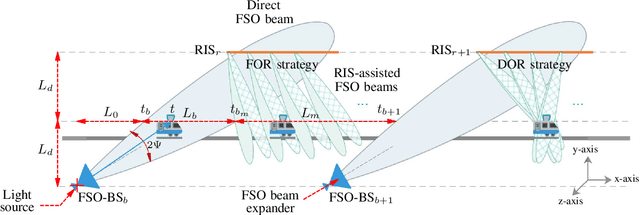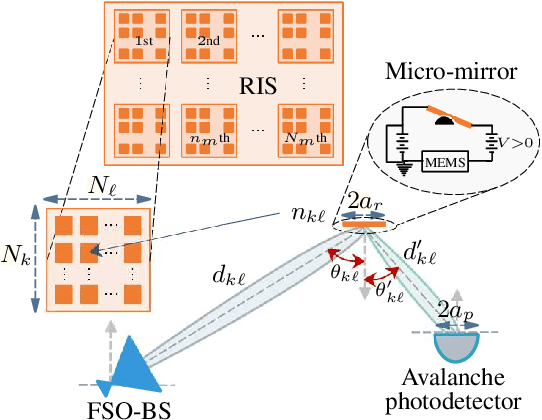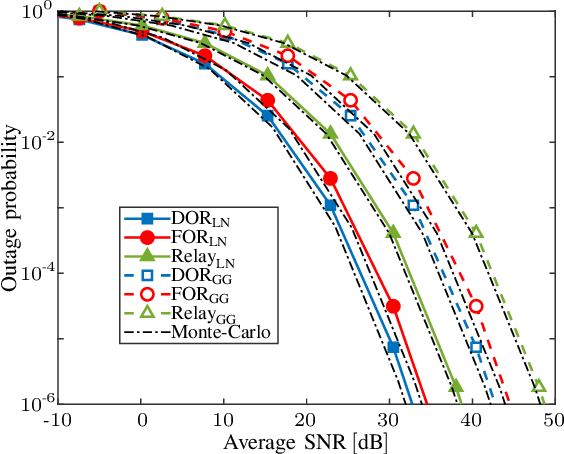Pouya Agheli
Learning-Based Multiuser Scheduling in MIMO-OFDM Systems with Hybrid Beamforming
Jun 09, 2025Abstract:We investigate the multiuser scheduling problem in multiple-input multiple-output (MIMO) systems using orthogonal frequency division multiplexing (OFDM) and hybrid beamforming in which a base station (BS) communicates with multiple users over millimeter wave (mmWave) channels in the downlink. Improved scheduling is critical for enhancing spectral efficiency and the long-term performance of the system from the perspective of proportional fairness (PF) metric in hybrid beamforming systems due to its limited multiplexing gain. Our objective is to maximize PF by properly designing the analog and digital precoders within the hybrid beamforming and selecting the users subject to the number of radio frequency (RF) chains. Leveraging the characteristics of mmWave channels, we apply a two-timescale protocol. On a long timescale, we assign an analog beam to each user. Scheduling the users and designing the digital precoder are done accordingly on a short timescale. To conduct scheduling, we propose combinatorial solutions, such as greedy and sorting algorithms, followed by a machine learning (ML) approach. Our numerical results highlight the trade-off between the performance and complexity of the proposed approaches. Consequently, we show that the choice of approach depends on the specific criteria within a given scenario.
Pull-Based Query Scheduling for Goal-Oriented Semantic Communication
Mar 09, 2025



Abstract:This paper addresses query scheduling for goal-oriented semantic communication in pull-based status update systems. We consider a system where multiple sensing agents (SAs) observe a source characterized by various attributes and provide updates to multiple actuation agents (AAs), which act upon the received information to fulfill their heterogeneous goals at the endpoint. A hub serves as an intermediary, querying the SAs for updates on observed attributes and maintaining a knowledge base, which is then broadcast to the AAs. The AAs leverage the knowledge to perform their actions effectively. To quantify the semantic value of updates, we introduce a grade of effectiveness (GoE) metric. Furthermore, we integrate cumulative perspective theory (CPT) into the long-term effectiveness analysis to account for risk awareness and loss aversion in the system. Leveraging this framework, we compute effect-aware scheduling policies aimed at maximizing the expected discounted sum of CPT-based total GoE provided by the transmitted updates while complying with a given query cost constraint. To achieve this, we propose a model-based solution based on dynamic programming and model-free solutions employing state-of-the-art deep reinforcement learning (DRL) algorithms. Our findings demonstrate that effect-aware scheduling significantly enhances the effectiveness of communicated updates compared to benchmark scheduling methods, particularly in settings with stringent cost constraints where optimal query scheduling is vital for system performance and overall effectiveness.
Integrated Push-and-Pull Update Model for Goal-Oriented Effective Communication
Jul 19, 2024



Abstract:This paper studies decision-making for goal-oriented effective communication. We consider an end-to-end status update system where a sensing agent (SA) observes a source, generates and transmits updates to an actuation agent (AA), while the AA takes actions to accomplish a goal at the endpoint. We integrate the push- and pull-based update communication models to obtain a push-and-pull model, which allows the transmission controller at the SA to decide to push an update to the AA and the query controller at the AA to pull updates by raising queries at specific time instances. To gauge effectiveness, we utilize a grade of effectiveness (GoE) metric incorporating updates' freshness, usefulness, and timeliness of actions as qualitative attributes. We then derive effect-aware policies to maximize the expected discounted sum of updates' effectiveness subject to induced costs. The effect-aware policy at the SA considers the potential effectiveness of communicated updates at the endpoint, while at the AA, it accounts for the probabilistic evolution of the source and importance of generated updates. Our results show the proposed push-and-pull model outperforms models solely based on push- or pull-based updates both in terms of efficiency and effectiveness. Additionally, using effect-aware policies at both agents enhances effectiveness compared to periodic and/or probabilistic effect-agnostic policies at either or both agents.
High-Speed Trains Access Connectivity Through RIS-Assisted FSO Communications
Oct 25, 2021



Abstract:Free-space optic (FSO) is a promising solution to provide broadband Internet access for high-speed trains (HSTs). Besides, reconfigurable intelligent surfaces (RIS) are considered as hardware technology to improve performance of optical wireless communication systems. In this paper, we propose a RIS-assisted FSO system to provide access connectivity for HTSs, as an upgrade for the existing direct and relay-assisted FSO access setups. Our motivation is mainly based on well-proven results indicating that a RIS-assisted optical wireless system, with a large enough number of RIS elements, outperforms a relay-assisted one thanks to its programmable structure. We firstly compute the statistical expressions of the considered RIS-assisted FSO channels under weak and moderate-to-strong fading conditions. Then, the network's average signal-to-noise ratio and outage probability are formulated based on the assumed fading conditions, and for two fixed- and dynamic-oriented RIS coverage scenarios. Our results reveal that the proposed access network offers up to around 44% higher data rates and 240% wider coverage area for each FSO base station (FSO-BS) compared to those of the relay-assisted one. The increase of coverage area, on average, reduces 67% the number of required FSO-BSs for a given distance, which results in fewer handover processes compared to the alternative setups. Finally, the results are verified through Monte-Carlo simulations.
UAV-Assisted Underwater Sensor Networks using RF and Optical Wireless Links
Apr 27, 2021



Abstract:Underwater sensor networks (UWSNs) are of interest to gather data from underwater sensor nodes (SNs) and deliver information to a terrestrial access point (AP) in the uplink transmission, and transfer data from the AP to the SNs in the downlink transmission. In this paper, we investigate a triple-hop UWSN in which autonomous underwater vehicle (AUV) and unmanned aerial vehicle (UAV) relays enable end-to-end communications between the SNs and the AP. It is assumed that the SN--AUV, AUV--UAV, and UAV--AP links are deployed by underwater optical communication (UWOC), free-space optic (FSO), and radio frequency (RF) technologies, respectively. Two scenarios are proposed for the FSO uplink and downlink transmissions between the AUV and the UAV, subject to water-to-air and air-to-water interface impacts; direct transmission scenario (DTS) and retro-reflection scenario (RRS). After providing the channel models and their statistics, the UWSN's outage probability and average bit error rate (BER) are computed. Besides, a tracking procedure is proposed to set up reliable and stable AUV--UAV FSO communications. Through numerical results, it is concluded that the RSS scheme outperforms the DTS one with about 200% (32%) and 80% (17%) better outage probability (average BER) in the uplink and downlink, respectively. It is also shown that the tracking procedure provides on average 480% and 170% improvements in the network's outage probability and average BER, respectively, compared to poorly aligned FSO conditions. The results are verified by applying Monte-Carlo simulations.
 Add to Chrome
Add to Chrome Add to Firefox
Add to Firefox Add to Edge
Add to Edge